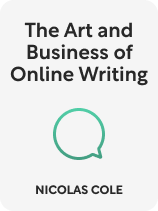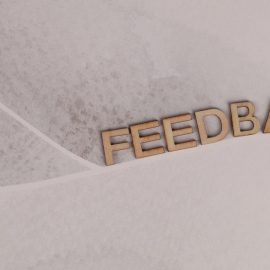

This article is an excerpt from the Shortform book guide to "The Art and Business of Online Writing" by Nicolas Cole. Shortform has the world's best summaries and analyses of books you should be reading.
Like this article? Sign up for a free trial here.
Are you struggling to create engaging online content? Do you want to learn how to write articles that captivate your audience?
In his book The Art and Business of Online Writing, Nicolas Cole shares valuable insights on online content creation. He provides tips for crafting compelling pieces, from choosing a clear focus to organizing your content effectively.
Keep reading to discover how you can elevate your writing and connect with readers in the digital space.
Tip #1: Have a Clear Focus for Your Piece
According to Cole, successful online content creation first requires you to have a clear focus for what you’re writing. You must determine the piece’s topic form, and content, as well as your credibility on the topic.
(Shortform note: If you’re writing fiction, you may need to take a few additional steps to ensure a clear focus. For example, experts recommend planning things like the central conflict, story arc, characters, and subplots, and then writing a detailed plot outline before you start writing.)
If you don’t have a niche yet, Cole recommends choosing a few different topics (or genres) you’re interested in and alternating between them—for example, poetry, relationships, and book reviews.
(Shortform note: In On Writing Well, William Zinsser offers eight popular genres of nonfiction writing you may want to consider: interviews, humor, travel, sports, criticisms, memoir, science and technology, and business.)
Next, choose the form of writing you’ll share. Cole describes five forms of successful writing:
1) Actionable guides provide detailed “how to” instructions. For example, a guide on how to write an essay might explain how to brainstorm, organize, use proper language, and so on.
2) Opinion pieces share your opinion and explain why you’re credible—for example, a guide outlining how to choose a contractor coming from someone who’s learned from their past mistakes.
3) Lists are usually simplified ways of informing people about something. For example, a list piece might provide 15 easy recipes that use tomatoes.
4) Stories are pieces of content that pull readers in through entertaining narratives and sometimes also aim to inform through storytelling. For example, you might tell a story about how your backpacking trip through Greece taught you what you actually need to pack versus what you think you need.
5) Source of credibility content pieces can be any of the above, but they’re written and read because the author is a primary source of credibility in the area. For example, an Olympic runner might write an opinion article or list about who they think will win Olympic track events.
Then, you must choose the content of the piece—what are you giving the reader? Cole says there are seven types of content: explanations, habits, mistakes, lessons, tips, stories, or timely events (for example, sharing breaking news).
| Traditional Classifications of Writing Traditionally, writing is broken down into five main categories, which more broadly classify writing in comparison to Cole’s approach. Many of Cole’s forms and content types are more specific methods of expressing traditional writing categories, and therefore may exclude forms of writing you might be interested in, like poetry or research articles. To expand Cole’s list, let’s compare these traditional categories to Cole’s and consider any additional writing forms they might include: 1) Persuasive Writing: This style tries to convince the reader of the validity of an opinion or argument. It would typically encompass Cole’s concept of opinion pieces and the most common type of content would be explanations, but it could arguably share any type of content Cole discusses. For example, a book review is a form of persuasive writing. 2) Narrative Writing: This style relays information in a story format centered around characters, conflict, and setting. It would typically encompass Cole’s concept of stories (form and content) but could share any type of content Cole discusses. For example, novels, poetry, and historical accounts can all be considered narratives. 3) Expository Writing: This style seeks to explain something or share information and focuses on facts rather than opinions. It would typically encompass Cole’s concepts of actionable guides and sources of credibility, but it could also include lists as long as you’re sharing facts rather than opinions. For example, scientific writing is expository. 4) Descriptive Writing: This style is used to paint a picture for the reader. It would typically encompass Cole’s concept of stories (form and content), but could also be employed in any form and encompass any type of content. For example, poetry and memoirs rely on descriptive writing. 5) Creative Writing: This is a broad style encompassing writing forms that don’t fit into the other four categories; however, creative writing tends to focus on entertaining and engaging the reader. This would encompass, for example, a list that is written for entertainment purposes and doesn’t fit perfectly into any other traditional writing style—for example, a list of “The 5 Best Romantic Movies of Last Year.” Creative writing could encompass any content form Cole discusses. |
Finally, what gives your writing credibility? Cole says there are three reasons you could be credible—you’re an expert on the topic, you’re sharing insights from other experts, or you’re just sharing your opinion.
(Shortform note: Credibility comes easily if you’re an expert or sharing expert insights—expertise is inherently credible. However, sharing your opinion doesn’t naturally grant credibility if you’re not qualified. Other experts offer a few suggestions to help convince your audience you’re credible even without expertise. For example, avoid repeating words in close proximity to each other, and don’t change the order in which you present information—if you say you’re going to talk about X, Y, and Z, don’t discuss Y first, then Z, then X. Further, have others fact-check your information before publication to ensure everything you say is accurate.)
Let’s put Cole’s ideas together in one hypothetical piece. In this piece, your focus might be a list explaining how to know your relationship is going well. The content of the piece might be explanations of signs to look for. Finally, your credibility might be that you’re a relationship therapist.
Tip #2: Create a Compelling Title
The next factor in writing successfully, says Cole, is creating a title that sparks a reader’s curiosity and draws them in. Compelling titles contain three components: what the piece is about, who it’s relevant to, and what it will provide readers (answers, solutions, and so on).
This requires you to determine who your audience will be. Your audience may be a niche group, or it may be the general public. If your audience is niche—say, people with depression who are in a relationship—your title should be more specific, for example “5 Signs Your Relationship Is Healthy If You’re Depressed.” If your audience is the general public (anyone in a relationship), your title might be more general, for example “5 Signs Your Relationship Is Healthy.” Both titles specify what the article’s about and what the reader’s gaining—signs their relationship is healthy—while also specifying who will benefit from the piece.
(Shortform note: In Breakthrough Advertising, Eugene M. Schwartz offers advice for writing product ad titles that you can use to strengthen the headlines of your pieces. In addition to saying who your article is for, what it offers, and what it’s about, he says, your title should make a dramatic statement. This serves to capture the reader’s attention, surprise them, and get them curious. To create an effective title, you need to research what your audience wants, how knowledgeable they are about the topic, and how aware they are of your competition—the last point allows you to offer something new or better.)
Tip #3: Organize Your Piece Effectively
Finally, Cole says you must organize your piece effectively so that it catches the reader’s attention. It must be clear and concise, and it should reveal new information quickly. There are three main sections that you must decide how to organize: the introduction, the body, and the conclusion.
The Introduction
The introduction outlines what the piece is about and what it’s offering. Aim for your introduction to be five lines long.
1) One opening sentence: This sentence should aim to express the main point of the piece in roughly 10 words.
2) Three expanding sentences: These sentences should 1) clarify or elaborate on the opening sentence, 2) reinforce your point with a form of credibility, and 3) wrap up the argument and prepare for the concluding sentence.
For longer or more complex pieces that may require further explanation in the introduction, include one or two additional descriptive sentences.
3) Concluding sentence: This should wrap up your point.
The Body
The body of your piece houses your main points. Cole says the length and organization of each point in the body largely depends on how many points you’re making. To keep the reader engaged, the average length of a piece should be around 1,000.
The Conclusion
Cole says there are three main ways you can conclude your piece:
1) A summary: This is most useful when your discussion is long or complex and readers may need a recap of the most important points.
2) A cliffhanger: This leaves the reader wanting more. Cliffhangers only require a few lines—imagine you’re metaphorically “dropping the mic.” This cliffhanger makes the reader want to know more—about how they can improve their relationship or what other factors they need to succeed. They’ll be likely to seek out more articles written by you.
3) A strong opinion: This is one of the best options if you want to end with a strong final point. The concluding point should connect all the points you’ve already made. Organize this paragraph using the same format as a body paragraph.
Exercise: Brainstorm Content Ideas
To write a successful piece, Cole says you must have a clear focus. In this exercise, we’ll use his guidelines to brainstorm some clear content ideas so you can start writing.
- What are three topics you’d like to start writing about? For example, possible topics include relationships, science, and book reviews.
- Select the topic that most interests you from the list above and then determine what form of writing you want to use. For example, if you want to write about relationships, you might choose to write a list about signs of relationship health.
- Next, consider which content you’ll provide. For example, if you’re writing a list of signs that indicate a healthy relationship, your content might naturally be explanations of each item in the list.
- Finally, why are you credible? For example, maybe you’re a relationship specialist (an expert), or maybe you’re basing your advice on your own personal experience or opinions.

———End of Preview———
Like what you just read? Read the rest of the world's best book summary and analysis of Nicolas Cole's "The Art and Business of Online Writing" at Shortform.
Here's what you'll find in our full The Art and Business of Online Writing summary:
- The two things you must do to create a successful online writing career
- How often you should publish online
- Where to post your content for maximum impact






